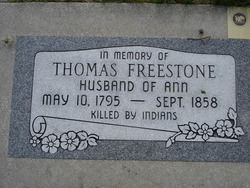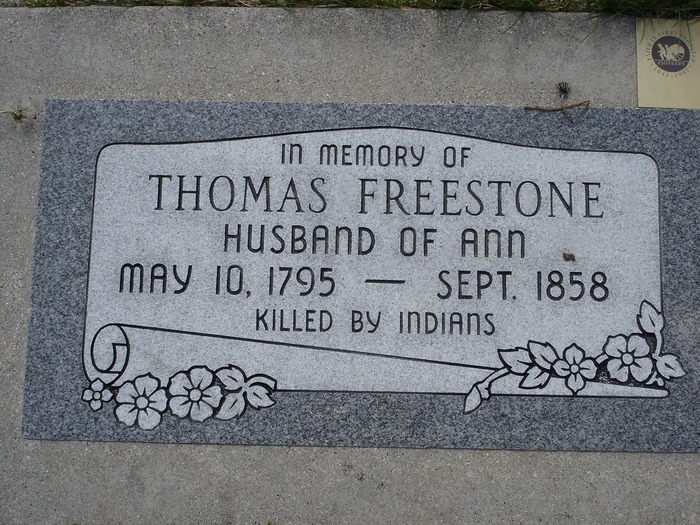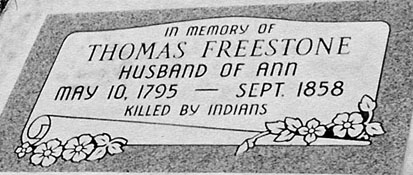In about 1825 Thomas left England to emigrate to Prince Edward Island, Canada. on 1 August 1836, Thomas, now forty-two years old, married Ann Fall, age twenty-four. Ann was born in England, too, on 6 August 1812 in Aldborough, Yorkshire, and had moved to Prince Edward Island with her parents in about 1818. Ann was a gentle, religious, refined lady.
This couple sought to improve their fortunes by moving in 1840 to the U.S.A. They settled on a farm in central Ohio. Life was good for these faithful Methodists. They loved the soil which they farmed, and prospered modestly for a few years while their children were being born -- George in 1838, James in 1840, Elizabeth Ann in 1842, Rhoda in 1844, Phoebe Ellen in 1847 (she died as an infant), Mary in 1848 (died before Jul 1850), Johanna in 1849, Emma Sarah in 1852 and Jane Marie in 1855 -- nine children in all, of which seven lived to adulthood.
The LDS missionaries came in 1850 and the family joined the church. In about 1851 they lost their farm, which had been mortgaged to pay for a season of severe illness. In 1852, they felt the spirit of gathering to Zion, sold another small acreage they had and all their other possessions, acquired a wagon and, in late summer, joined the Saints who were heading west. They struggled through fall rains and mud and reached Mt. Pisgah in Iowa in a snowstorm on Christmas Day.
The family stayed in Mt. Pisgah, Iowa, over the winter of 1852-53, and finally, with help from kind fellow Saints, arrived in deep poverty at Winter Quarters. On their journey, Thomas and older boys had worked at anything they could do for food or money to sustain them. When they reached Council Bluffs in the spring, they found an emigrating company nearly ready to leave for the West. Again they found help from other Saints, quickly acquired an outfit and supplies, and joined them.
In late 1853 they arrived in American Fork. One year later the family moved to "Mountainville" (later named Alpine) where they lived in the fort for protection against the Indians, while they began to re-establish their affairs. Exerting all their efforts, they partially overcame their hunger by eating roots, pigweed and wild onions, and beat back enough crickets to raise a full crop of grain. In spite of their many trials the hardy family hung on to their testimonies and endured.
In 1858, the Freestone family had been in Utah five years. Thomas was sixty-three years old. The family discussed the possibility of moving to another location where they might find more security. Thomas went to Southern Utah on a scouting mission, probably looking for a new family location.
Stories that have been handed down in the Freestone family are: An Indian later found Thomas Freestone after he had been stoned, mutilated and in extreme pain. The Indian felt he would do him a favor by killing him and ending the pain. The Indian killed him, then wrapped him in his blankets and buried him. This Indian sent a message to Ann Fall Freestone or went in person to tell her that her husband was dead by the hand of the Indians and had been killed and buried near Parowan, Iron County, Utah. As far as we know no white man knows where the grave of Thomas Freestone is. It is stated that the Indians had a plot to kill the first white man who crossed a certain trail and he was that man.
The older boys became the providers for the growing family. Three years later George married and left home. Four years after Thomas' death, Ann visited with her bishop about their difficult circumstances. He advised her to marry again and introduced her to a man named Andrew Hodnett. The two went to the Endowment House in Salt Lake City and were married the very next day. Hodnett proved to be a good provider for the family.
With the unmarried children, they moved to Orderville and put all their sheep into the United Order (retrieving them again later when the Order failed). Ann's health and eyesight failed in her later years and she moved back to Alpine to live in the home of her youngest daughter. She died there on Christmas day in 1888, at age seventy-six.
In about 1825 Thomas left England to emigrate to Prince Edward Island, Canada. on 1 August 1836, Thomas, now forty-two years old, married Ann Fall, age twenty-four. Ann was born in England, too, on 6 August 1812 in Aldborough, Yorkshire, and had moved to Prince Edward Island with her parents in about 1818. Ann was a gentle, religious, refined lady.
This couple sought to improve their fortunes by moving in 1840 to the U.S.A. They settled on a farm in central Ohio. Life was good for these faithful Methodists. They loved the soil which they farmed, and prospered modestly for a few years while their children were being born -- George in 1838, James in 1840, Elizabeth Ann in 1842, Rhoda in 1844, Phoebe Ellen in 1847 (she died as an infant), Mary in 1848 (died before Jul 1850), Johanna in 1849, Emma Sarah in 1852 and Jane Marie in 1855 -- nine children in all, of which seven lived to adulthood.
The LDS missionaries came in 1850 and the family joined the church. In about 1851 they lost their farm, which had been mortgaged to pay for a season of severe illness. In 1852, they felt the spirit of gathering to Zion, sold another small acreage they had and all their other possessions, acquired a wagon and, in late summer, joined the Saints who were heading west. They struggled through fall rains and mud and reached Mt. Pisgah in Iowa in a snowstorm on Christmas Day.
The family stayed in Mt. Pisgah, Iowa, over the winter of 1852-53, and finally, with help from kind fellow Saints, arrived in deep poverty at Winter Quarters. On their journey, Thomas and older boys had worked at anything they could do for food or money to sustain them. When they reached Council Bluffs in the spring, they found an emigrating company nearly ready to leave for the West. Again they found help from other Saints, quickly acquired an outfit and supplies, and joined them.
In late 1853 they arrived in American Fork. One year later the family moved to "Mountainville" (later named Alpine) where they lived in the fort for protection against the Indians, while they began to re-establish their affairs. Exerting all their efforts, they partially overcame their hunger by eating roots, pigweed and wild onions, and beat back enough crickets to raise a full crop of grain. In spite of their many trials the hardy family hung on to their testimonies and endured.
In 1858, the Freestone family had been in Utah five years. Thomas was sixty-three years old. The family discussed the possibility of moving to another location where they might find more security. Thomas went to Southern Utah on a scouting mission, probably looking for a new family location.
Stories that have been handed down in the Freestone family are: An Indian later found Thomas Freestone after he had been stoned, mutilated and in extreme pain. The Indian felt he would do him a favor by killing him and ending the pain. The Indian killed him, then wrapped him in his blankets and buried him. This Indian sent a message to Ann Fall Freestone or went in person to tell her that her husband was dead by the hand of the Indians and had been killed and buried near Parowan, Iron County, Utah. As far as we know no white man knows where the grave of Thomas Freestone is. It is stated that the Indians had a plot to kill the first white man who crossed a certain trail and he was that man.
The older boys became the providers for the growing family. Three years later George married and left home. Four years after Thomas' death, Ann visited with her bishop about their difficult circumstances. He advised her to marry again and introduced her to a man named Andrew Hodnett. The two went to the Endowment House in Salt Lake City and were married the very next day. Hodnett proved to be a good provider for the family.
With the unmarried children, they moved to Orderville and put all their sheep into the United Order (retrieving them again later when the Order failed). Ann's health and eyesight failed in her later years and she moved back to Alpine to live in the home of her youngest daughter. She died there on Christmas day in 1888, at age seventy-six.
Gravesite Details
Killed by Indians
Family Members
Advertisement
Records on Ancestry
Sponsored by Ancestry
Advertisement











